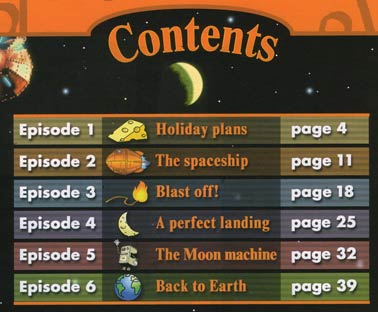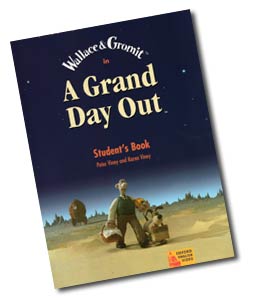 |
A Grand Day Out
by Nick Park
ELT Adaptation by Peter Viney & Karen Viney
Student’s Book by Peter Viney & Karen Viney
Teacher’s Guide by Lorena Roberts
Components
Student’s Book ISBN 0 19 459245 6
Teacher’s Book ISBN 0 19 459246 4
VHS PAL video ISBN 0 19 459247 2
VHS SECAM video ISBN 0 19 459249 9
VHS NTSC video ISBN 0 19 459248 0
DVD ISBN 0 19 459238 3
Published by Oxford University Press, 2003
© Oxford University Press and Aardman ™/ Wallace
and Gromit Ltd |
Introduction
The Wallace and Gromit films are enormously popular with audiences
of all ages so in The Wrong Trousers and A Close Shave
the Student’s Book activities have been designed so that they
are suitable for a wide age range.
A Grand Day Out is the lowest in level of our three adaptations,
and the Student Book has been designed with children in mind, and
the activities are more child-orientated than in The Wrong Trousers
or A Close Shave.
| Level
|
Wallace
& Gromit video
|
Age
range |
| Early
beginner |
A
Grand Day Out |
All
ages, but mainly 7 to 13 |
| Beginner
/ Starter |
The
Wrong Trousers |
All
ages (7-90) |
| Ememtary
/ Pre- Intermediate |
A
Close Shave
|
All
ages (7-90) |
The ELT adaptations of the videos correspond in order of difficulty
to the order of publication of the original films.Together they
form a series with a progressive syllabus.
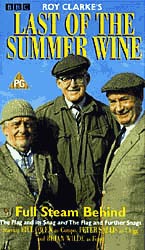 |
 |
|
Peter Sallis is on the right. |
Stephen Tompkinson |
In all three Wallace and Gromit videos, the
visuals, music and sound effects are identical to the original
versions. However, in the ELT Adaptations the language level
has been greatly simplified and a narrator has been added.
Wallace is played in both the original version and in this
ELT Adaptation by Peter Sallis, an actor famous for his portrayal
of a Yorkshireman in a long-running British comedy The
Last of the Summer Wine.
The story is narrated by Stephen Tompkinson who starred in
the film Brassed Off and the TV series Ballykissangel. |
The activities in the Student’s Book are aimed at beginner
level. With higher levels, however, the video can be used effectively
for revision purposes and the teaching notes offer numerous suggestions
for ways in which the language and the Student’s Book activities
can be extended.
A Grand Day Out has been broken down into six short episodes:
Language syllabus (from the Teacher’s
Guide):
| episode |
contextualized
major structures |
contextualized
minor structures |
structures in SB
exploitation of story |
| one |
Let's...
(Are you) going (on holiday?)
No (cheese)
can (Where can we go?)
made of |
Where?
I like (tea)
Skiing, camping
Wake up!
countries |
like / don't like
made of (plastic, metal)
Let's go ;
Let's have... |
| two |
Present
continuous
Imperatives (including Be.../ Don't...)
down, up |
Who?
Too late!
Let go!
Sorry. Well done! |
colours
imperatives
present continuous
can hear (+ noises) |
| three |
has got
haven't got
Imperatives(many examples) |
ready (We're ready)
Let me (see)
numbers (60 >>>) |
have got
counting |
| four |
has
got / have got
present continuous
Questions to be: Are you ready? / bored?
can't |
What's
that?
That's a nice photo.
Slowly.
I don't know.
What kind (is it)? |
|
| five |
Imperatives
has got |
broken
closed
That's better |
present continuous
can see / can hear
has got
It's got (3 wheels) |
| six |
I've
got.../ It's got...
can't (It can't climb)
wants + to do
summary |
The
money's run out
We must (light the fuse)
What's wrong?
more
inside / outside |
Uses all main structures:
has got, pres continuous,
to be, can / can't,
imperatives |
The Student’s
Book
For each episode the Student’s Book contains the following
material:
Watching the video
Four pages of activities for classroom exploitation. We recommend
allowing a double lesson (90 – 100 minutes) to benefit fully
from the video and the suggested activities.
The activities are based around the following viewing stages:
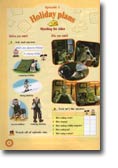
Episode 1 Viewing the complete episode
- download
sample (PDF) |
1 Viewing of the complete
episode
At this level it is best to show the students the whole episode
before breaking it down for more detailed language work. This
encourages students to watch and listen in order to understand
the gist of what is happening and provides a context for the
activities which follow. There is a pre-watching activity
and a post-watching activity for each episode.
|
|
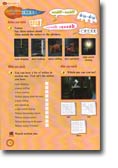
Episode 2, Section 1 Before you watch,
While you watch and After you watch activities - download
sample (PDF)
|
2 Viewing the episode
in sections
Each of the episodes is divided into two sections. Breaking
the episodes down in this way enables a better understanding
of the story and allows for more thorough exploitation of
the language.
|
For each of the viewing stages there are various activities with
different aims and objectives as follows:
Before you watch activities
These pre-viewing tasks have been designed to do one or more of
the following:
• pre-teach key vocabulary
• introduce a key structure
• set the scene
While you watch activities
These tasks are either observational activities in which students
are asked to watch and/or listen for specific details or checking
activities in which students watch in order to check their answers
to a previously completed exercise.
After you watch activities
By this stage, students should be fairly familiar with the sequence.
These tasks encourage students to focus on a variety of aspects
such as:
• idiomatic expressions
• sequencing and narrating events
• comprehension
• language review
3 Watching the whole episode again
It’s important to let students watch the whole episode again,
after they have completed all the activities and practised the language.
As well as being enjoyable, it also enables the students to appreciate
how much more they can now understand as a result of the work they
have done.
Practice
There are two pages of practice activities at the end of each episode.
These activities, although based on the story, aim to provide further
practice and extension of the key vocabulary and structures. They
can be done in a subsequent lesson without reference to the video,
and build on the interest in the episode. With faster classes, they
can be done with the Watching the Video exploitation.
Practice activities include:
• Pairwork activities on the structures
• Word games
• Vocabulary building
• Oral chants
• Picture stories
• Spelling exercises
• Number exercises
• Matching activities
• Mime activities
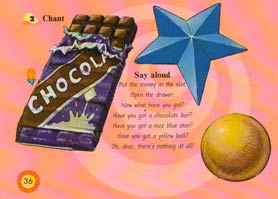 |
| Episode 5 A chant from the
Practice section |
| 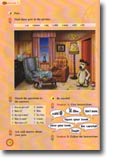
|
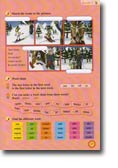
|
Episode 2 Practice- Picture / vocabulary
activity; Matching questions and answers; Pair work activity
- download
sample (PDF) |
Episode 5 Picture story and Word games from
the Practice section - download
sample (PDF) |
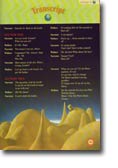 download
Episode 6 Transcript - download
sample (PDF) download
Episode 6 Transcript - download
sample (PDF) |
Transcripts
The transcripts have been provided as reference to use after
the lesson. Students often like to read the transcripts, make
notes and add translations. This is usually done at home and
should not be discouraged as any extra work can only be advantageous.
However, we would not advise teachers to use the transcripts
before any of the viewing stages, rather as a review, particularly
with higher levels. |
|
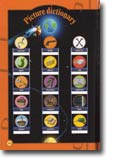
download Picture Dictionary - download
sample (PDF) |
Picture Dictionary
There are three reference pages at the end of the book. These
are bright and colourful and students can write in their own
translations. Because of the story content, this is important
as the story naturally introduces vocabulary outside the normal
range of the level.
|
|
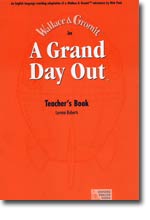
|
The Teacher’s Book
by Lorena Roberts
The comprehensive Teacher’s Book contains:
•
An introduction on teaching with video
• A syllabus
chart
• Notes on teaching younger learners with video
• Step-by-step teaching notes for the Student Book
• Alternative activities for higher levels
•
Culture and background notes
• Game activities for
younger learners related to the syllabus |
Back to the Wallace & Gromit homepage |



